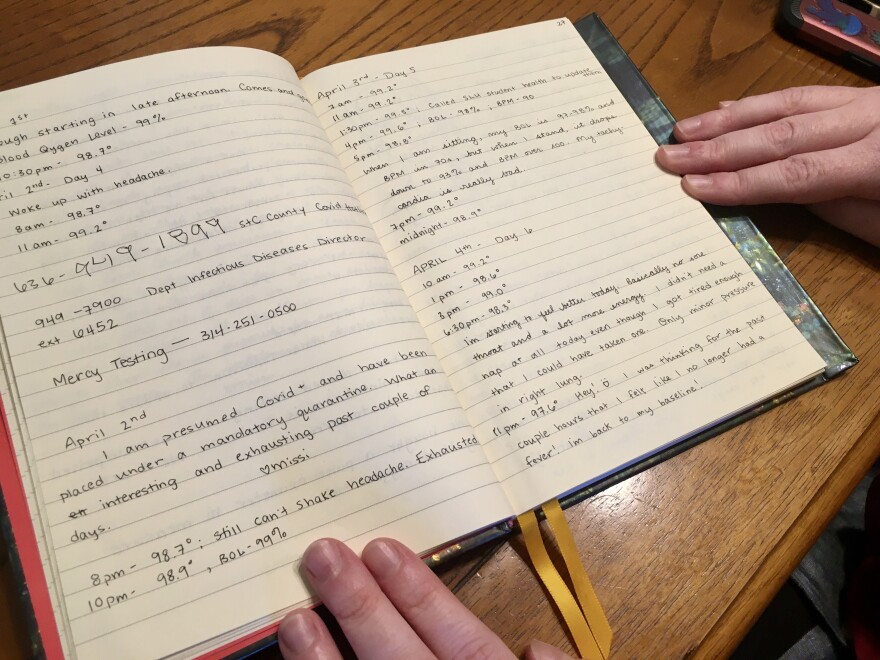Clifford Mcintyre had been sick with pneumonia before. So when the 49-year-old started coughing and having trouble breathing a few weeks ago, he went to the doctor in search of the usual treatment, a steroid shot.
But the nasty cough didn’t go away. Soon, McIntyre couldn’t breathe. He went to the hospital, and within hours he was hooked to a ventilator, fighting to stay alive. A test later showed he had COVID-19.
“COVID feels like you’re drowning,” McIntyre said. “You're out in the water, and you’re trying to reach the top, you can’t breathe and you’re panicking.”
Early in the coronavirus pandemic, doctors described COVID-19 as a virus with symptoms identical to the flu – coughing, shortness of breath and fever. But recovered patients say it’s much worse: a painful, unpredictable sickness combined with a lonely, scary recovery.
People who have COVID-19 can experience nausea, dizziness, loss of taste, muscle pain and shaking chills. Even the milder forms of the disease incapacitate otherwise healthy patients for weeks.
“This is something I never had before,” said Tom Frank, a retired Boeing employee who lives in O’Fallon, Missouri. “It’s like having the flu with an attitude. It was just an unbearable feeling.”
Feelings of uncertainty
For many, COVID-19 starts with a metallic taste, as if they have pennies in their mouths. Others describe not being able to taste anything at all.
But COVID-19’s signature characteristic is how it affects a person’s lungs. Many describe feeling like they had just run up a flight of stairs.
“I had a tightness in my lungs, like the heavy-duty rubber bands that you sometimes get on vegetable produce? It felt like those were around my lungs,” said Melissa Stone, a doctoral student in cognitive neuroscience at St. Louis University.
Frank, 61, said his body became so worn out from fighting the virus that even small tasks felt like running a marathon.

Feeling ambitious one morning, he decided to take a hot shower to ease the muscle aches.
“I probably stayed in the shower a bit too long,” he said. “I had a rush through my body, the fatigue set in, I was so tired. … I tried to sit down on the floor and my body just failed me.”
It wasn’t until after his dog, Austin, woke him that he realized he had passed out on the bathroom floor.
“I got up, dried myself off, limped back to bed and stayed in bed the rest of the day,” he said.
Unlike the cold or flu, the illness doesn’t follow a familiar course.
“I just didn’t know how it was going to go,” Stone said. “I didn’t know if I was going to hit day five or six and have a sudden turn and have to be hospitalized. The word ‘uncertainty’ kept echoing in my head.”
A serious turn
Some patients can stay miserably sick for weeks. For others, especially those with pre-existing conditions such as heart disease or respiratory problems, the virus can turn life-threatening.
Stone, 28, was worried. She has epilepsy and Ehlers-Danlos syndrome, a disease that affects connective tissues. “There were times in the first few days where I was like, ‘There’s no guarantee I could get over this,’” Stone said. Her fever began to rise.
“I remember lying in bed, and my cat was purring next to me,” she said. “And I thought, ‘I don’t know if I’ll have this a few days for now, I just have to enjoy these next few minutes.'”
McIntyre also was at risk. He has sarcoidosis, a disease that inflames tissues in the lungs. After his visit to his usual doctor for pneumonia, he started not being able to breathe.
His wife, Casonda, took him to St. Elizabeth’s Hospital in O’Fallon, Illinois. She watched a hospital employee roll her husband away from her car in a wheelchair. Because of the coronavirus, hospitals don’t allow loved ones inside with patients.

On the drive home from taking her husband to the emergency room, Casonda McIntyre received a call from the hospital. Doctors told her that he needed to be put on a ventilator immediately.
“I said it will be OK, but it was hard leaving him at the hospital,” she recalled. “I knew it was serious when they were putting him on a ventilator.”
Usually a patient is allowed to see loved ones before a serious procedure. But hospitals have barred visitors to keep the virus from spreading. Clifford McIntyre was alone with the hospital staff. He had watched grim stories on the news about how coronavirus patients who are put on ventilators are likely to die.
“I wasn’t able to see her; I wasn’t able to see my daughter or see the rest of my kids or my parents,” he said. “But not being able to see my loved ones, and then just hearing people getting on ventilators not making it out, I was extremely scared.”
McIntyre thought of the last times he had seen his wife, his daughter and his family. Hospital staff arranged a quick phone call to his wife before they gave him anesthesia.
“I told her I loved her and told her to tell my daughter, Taylor, I loved her. And she kind of calmed me down and told me everything's going to be OK.”
Getting better
McIntyre woke up a couple of days later as a nurse was changing his IV. Hospital staff had taken him off the ventilator after two days — a short time for a coronavirus patient.
He soon learned that his wife also had been hospitalized with COVID. She was in a hospital room a few floors away. She relayed the message to Clifford, using an ICU nurse as a courier.

After a week, Clifford McIntyre was able to leave. St. Elizabeth’s workers threw a small parking lot parade for him as he left.
“I went to my window and opened up my window and waited for him,” his wife, Casonda, said. “They brought him by my window, and we blew a little kiss at each other and did our little patting heart motion. And everyone was like, ‘We’ll be back soon; we’ll be back for you next!’ And I ended up leaving the next day.”
The coronavirus isn’t something to brush off, said Frank, the retired Boeing employee.
“Take this serious, OK? This is something you do not want to have, you do not want to transfer to your loved ones," he said.
The McIntyres have been at home recovering at home for the past week. They’re still tired, but they’re feeling better.
“I just thank God that me and my wife, we are survivors,” Clifford McIntyre said. “We made it through. Just through the grace of God, we’re here and we’re blessed.”
Hear Sarah Fentem's conversation with St. Louis on the Air host Sarah Fenske about reporting this story:
Follow Sarah on Twitter: @petit_smudge
Our priority is you. Support coverage that’s reliable, trustworthy and more essential than ever. Donate today.
Send questions and comments about this story to feedback@stlpublicradio.org





